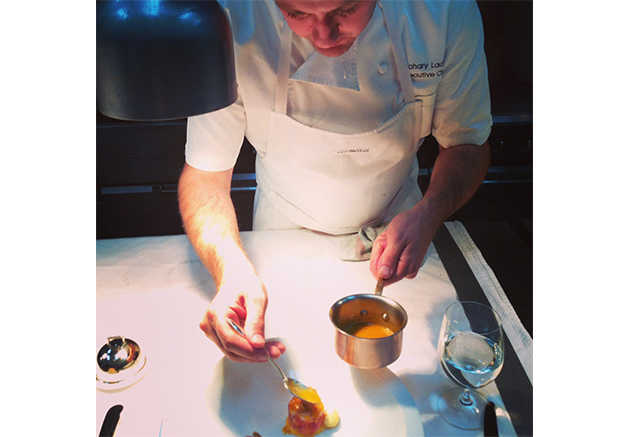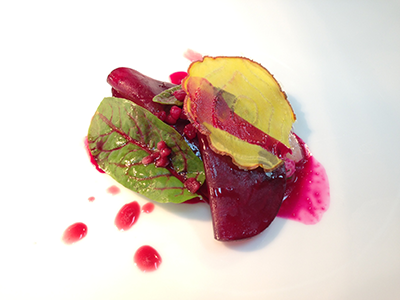
About an hour and a half outside of Houston on the way to Austin in the small farm town of Washington, Texas, you’ll find the only Forbes Travel Guide Five-Star restaurant in Texas: The Inn at Dos Brisas. If it seems like an unlikely place to find one the best restaurants in Texas, consider this: All the produce used by the restaurant is picked fresh daily from the 24-acre on-premises, certified-organic garden, which has its own greenhouse, orchard, herb garden and a chicken coop from which they get their eggs.
The rich bounty provides inspiration for executive chef Zachary Ladwig’s own brand of French haute cuisine, which often comes with Southern twists. Dishes are multilayered and strongly ingredient-driven, yet masterful in technique. Examples include lobster poached in beurre blanc (white butter), served with Cinderella pumpkin minestrone, or hand-harvested scallops, lightly seared and topped with freshly shaved black truffles, turnips and radishes from the garden. We recently sat down with Ladwig to learn more about his background and what he’s doing at The Inn at Dos Brisas.
Where are you from and what brought you to Texas?
I’m originally from Wisconsin. When Dos Brisas first became a Forbes [Travel Guide] Five-Star restaurant, I looked [the Inn] up a couple of times, but I never really thought that I would ever work here. What convinced me to come was Raj Dixit (the executive chef at the inn who preceded me). Raj and I had a really great working relationship at [Forbes Travel Guide Four-Star] Bouley — he was the chef de cuisine when I was a sous chef there, and we just worked really well together.
Tell us about your background in terms of training and the more significant experiences that shaped you as a chef today.
I spent a good amount of time in New York. I started out at [Forbes Travel Guide Four-Star] Gordon Ramsay at The London during the first year that it opened, and worked my way around that kitchen as a roundsman. From there I went to work for David Bouley at Bouley — that’s where I ultimately met Raj. Bouley was different. It was total restaurant madness all the time. We would work 9 a.m. to 2 a.m., six days a week, and it was really hard. Bouley wanted to reassert himself as a force to be reckoned with, and he’s eccentrically brilliant. He’s super smart, but he’s a [hard] worker; and he doesn’t mind being in the weeds. He would also wait until the last minute to challenge us. We might have lobster prepared, ready to use, and he’d tell us it wasn’t good enough — send us down Duane Street to get fresh lobster, come back, break it down and then serve it. It was sheer madness, but the thought process behind what he was doing — there’s no other chef that can cook like that. It was extraordinarily à la minute, inspired by the moment. Almost like Pierre Gagnaire [of Forbes Travel Guide Five-Star Twist by Pierre Gagnaire], but I think even more to the extreme. He had such an amazing palate — you didn’t really write down the recipes — but if you watched him, you could pick out the thought process of technique and flavor being the foremost components of cooking.
What did you take away from that experience?
I took away how to create a really mad kitchen. I’ll still do some of the things that he did to me to the cooks. We have very few recipes. We cook on taste and flavor and what’s around us. Chefs already cook that way, but we’re constantly tweaking things, adding and analyzing. The carrot sauce that was used yesterday is not enough to be the carrot sauce today. It’s a constant exploration of ingredients. What did I take away? I really learned how to taste things and how to look at an ingredient in an appropriate way, because it’s ingredient-centric.
Let’s take an ingredient you’re working with right now.
Fennel. Let’s look at fennel. What can I do with it and what goes with it? For me, I’m going to do a dish of fennel pudding with candied green fennel stems, with miso, burnt fennel crystallines, and salt roasted fennel bulb. So what [Bouley] really taught me is how to take an ingredient, break it down to its most elemental forms and put it all back together. A lot of the stuff that we do, especially what we do for dinner, is all little textural plays on a single ingredient or a single member of that vegetable family.
How would you describe what you’re doing here?
I would probably say that it’s garden-y Southern-French, where Southern refers to Texas-Southern; so the technique and composition is French, but we use local ingredients, many of them Southern. During certain times of the year, we’ll have black-eyed peas, collards. We’ve run really cool smoked brisket dishes. We try and use those ingredients to still give food a sense of place. Ninety-eight percent of the food is produced here. The vast majority of the meats come from within a 100-mile radius — we use Black Hill Farms [and] Augustus Ranch [Meat Company]. Fish is all over the board: We have two really good fish purveyors on the East [Coast], two guys on the Gulf [Coast] and two guys on the West Coast; and we kind of pick and choose what we want to work with that week. Some weeks we have live Santa Barbara spot prawns; some weeks we have East Coast uni (sea urchin).
Tell us about the menu at The Inn at Dos Brisas.
Lunch is a three-course prix fixe. Generally, lunch has four to five options for each course. Dinner is a choice of a five-course, the seven-course vegetarian menu and then a chef’s tasting, which starts at 12, but really ends up being 15 to 20 courses because we’ll have a whole bunch of stuff set up for the evening and then farmer Lisa [Roese] or farmer Jason [Coleman] will come by with new produce picked from the garden, which will inspire me to make new things on the fly — usually to the tune of three to five extra courses.
For someone staying at Four-Star The Inn at Dos Brisas, what is in-room dining like?
We have a three-course menu set up for the room. The choices are more classic: We have a brandied lobster bisque, a chestnut velouté and a Dos Brisas chopped salad — lettuce and herbs and everything from the garden. For the main courses, if there are two people in the room, we’ll do a 42-ounce Texas steak for two with mushrooms and bone marrow and onion jam, and then we’ll do a whole roast chicken from farmer Henry [Bryan] in Hempstead. We’ll glaze that down in honey and shave truffles over the top of it. And then we’ll do a fresh catch with a shellfish stew. Everything comes with three sides, such as a potato purée, a pumpkin galette and vegetable fricassee. For dessert, we’ll do a chocolate coulant, a New York-style cheesecake, and right now we’re doing an apple risotto.
Photos Courtesy of Mai Pham


